#fabric and cotton
Text
#fabric and cotton#fabric from cotton#clothing brands from india#cotton cloth fabrics#cotton material fabric#fabric cotton fabric#cotton fabric#organic fabric#painted fabric#silk fabrics#organic fabrics#"Sustainable Fabric#linen fabric#cottony fabric#fabric#fabrics#online fabrics#satin fabrics#WOOL FABRIC#silk sarees#fabrics linen
0 notes
Text
I'm a stiff breeze away from custom ordering my own organic fabrics and making my own damn clothes and im not joking
#if anybody knows where to get decent quality organic fabrics like silks or pima cotton or something hmu#i hate the fashion industry so much its unreal im not buying plastic bullshit made to fall apart that feels awful#not even to mention the unethical labor practices#i need to make my own weirdo dresses or ill doomspiral#fashion#casinos whining hour
454 notes
·
View notes
Text
I've been seeing a lot of Goochy content on tumblr and that makes me really happy, so I wanted to share my collection of Goochys (Goochies?)!

The two in front are my second newest and oldest Goochys, the oldest is around 20 now. Since this picture I've gotten one or two more. Idk I just love Goochy a lot!! And as a kid my life goal was to have the biggest collection of them in the world and I don't think that's changed
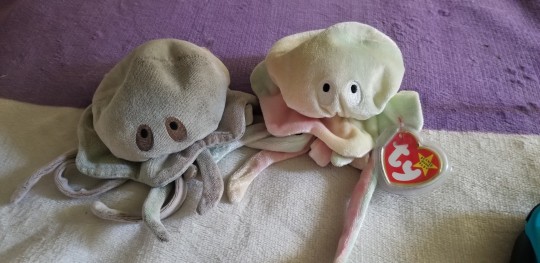
Have an extra picture: close-up of the same oldest Goochy, and my most recent one not in the first pic
(:。)ミ
#fun fact: goochy had the most expensive fabric to produce at the time#cause of the shimmery effect and the multicolors#idk if thats why it got retired but interesting regardless#and goochy comes in a rainbow color or a blueish#some of mine are gray cause theyre well loved ♡#goochy the jellyfish#goochy#beanie babies#beanie baby#cotton talks
2K notes
·
View notes
Text
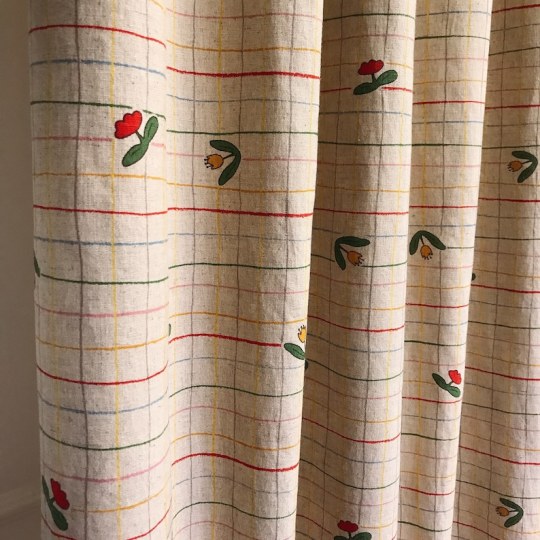
Multi-Color Stripes Tulips Pattern Washed Linen Cotton Curtain by enapremium
167 notes
·
View notes
Text

[begin id: A drawing reference/fullbody of Doctor Rat, specifically the character (?) he plays in Content SMP. Next to him are design notes, and a color palette of his colors. The design notes read: "-dress looks to be made of low quality, party city material. but, it's actually well taken care of, and clearly has been stiched over several times. -tons of pockets. tons. -oh defintely changes his heels up every now and then. i think he could gouge a man's eyes out with stilhettos. -ngl i think he looks like geronimo stilton."
As for the design itself, he is a tall half-rat man with a pink rat tail, and grey fur that covers where regular human body hair would go. He has curly purple hair, about shoulder length, and a grey mask with a blotch of lighter grey near the eyes. He's wearing a maid dress; consisting of a black dress with poofy sleeves, an apron, gloves, and wedged ankle mary janes. The apron and gloves are covered in dark but faded stains, and his dress is covered in scratch marks to indicate consistent and constant repair of it. As for the pose, he's standing straight, feet together. His left hand on his hip, the right standing idly by in a calmed fist. He's smirking. End id]
to people who loved my silly rat sketches. thank you very much. im reminding you all yet again that im a big nerd for character design forever and ever. thank you very much
[reblogs >>> likes | don't like without reblogging!! if you like and don't reblog i will curse your bloodline.]
#artists on tumblr#described art#accsesible art#image described art#character design#character sheet#content smp#contentsmp#doctor rat#doctor4t#the full armor design for rat i think'll take longer just because there's a lot more things to work out when you're designing armor#if people are interested ill make it but!! so far we have just a silly little rat sheet. hehe <33#also i might take back the party city thing?? but it does look like its made of cheap fabric#first i thought he'd have that shiny party city stuff. you know it its really cheap thin and shiny.#but as i drew i realized he'd moreso have like. cotton cheap stuff. like its slightly elevated above the shiny party city#maybe 20 or 30 dollars on amazon. but still a little cheap yk.#but it is not. its very well loved and taken care for. it mightve been made out of cheap materials originally but its now made of love.
121 notes
·
View notes
Text
thinking about puppet tattoo parlors. A wall covered in so many different thread colors to choose from - swatches of different types of stitch for different textures / effects. modified handheld sewing machines for tattooing with multiple settings for the different stitches. individual needles + embroidery thread as stick n pokes...
#THINKING SO HARD ABOUT THIS#wouldnt this be cool though???#cause i was thinking fondly of tattoos and went 'hm. how would a puppet do this?'#cause ink can bleed in fabric. it can scrub out. the lines wouldnt be as clean and i just dont think it would really Stick?#but EMBROIDERY! STITCHES! COOL SEWING GUNS INSTEAD OF TATTOO MACHINES!!!#and now im wondering Could They Remove Their Tattoos?#it would probably be pretty invasive!#hold on im doing research real quick#yeah looks like they'd need to lift their felt/fleece/skin to get at the back of the stitches#then sew the skin back together afterwards...#so to them tattoos would be just as permanent as they are to Us! because who wants to go through That!#im having a grand ol time imagining the Range their tattoos would have#textures! endless colors! glitter thread! metallic thread! wool! cotton! polyester! glow in the dark! scratch n sniff!#that last one was a joke.#imagining someone with an entire detailed forest scene carpeting their back... it has Depth...#absolutely unprompted#puppets#sundown summer is getting a motherfuckin tattoo if its the last thing i do#resisting the urge to just litter every puppet that i know of with this idea#YOU get a tattoo and YOU get a tattoo and YOU-
123 notes
·
View notes
Text
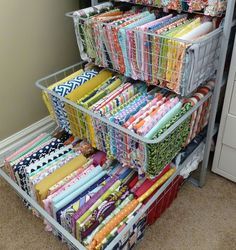
How to Build a Fabric Stash without Breaking the Bank
Fabric can be expensive but it doesn’t have to be. If you are not stuck on Name Brands or Specialty Fabric Store Exclusives here are some ways to build your fabric stash without costing an arm and a leg. I have made many beautiful quilts using various fabrics from various supplies. And I believe that the quality is not just in the fabric you use but also in your stitch work and seams sizes. If your seams are less than a ¼” they will not hold (personally I prefer to use a ½” seam allowance). If you are not securing your thread ends, your stitch work is going to come undone. So be sure to watch these things too.
Look for fabric at your local Thrift Store (Goodwill, Value Village, etc.)
I have found some wonderful fabrics in various sizes, notions, storage items and more at my local Thrift Stores. I have even found unfinished quilt tops that I have brought home and added a backing to then quilted. Remember that almost any size fabric remnant can be added to other remnants to make some wonderful scrappy quilts so save your own remnants after making a quilt, you may be able to use it later in another quilt.
Look for local Fabric Sales held by Quilting Guilds in Your Area.
We have 2 near me every summer.One charges $2 per pound for any fabric. The second one charges $2 per yard for any fabric. Both also sell batting, notions, books, machines, tools, and more.
Look for fabric on Facebook Marketplace, Nextdoor and other sites.
I sell extra fabric on Marketplace and Nextdoor. I have also found several ladies near me selling fabric that I have purchased. And some I have purchased with shipping to me.
Look for older 100% Cotton Sheets at your local Thrift Stores.
Back in the 1800’s and early 1900’s, Quilts were not show pieces. They were real functional blankets that were made from any and all fabrics they could get, usually used clothing. I think there is no reason why we cannot still do that instead of buying expensive fabrics. I have often used clothing, sheets, curtains, and other linens to make some wonderful, usable quilts. And there are some wonderful patterns you can use for quilts in bedsheets from the 1980’s and 1990’s. Note: I always wash anything from a Thrift Store before I use it.
Watch for Fabric Sales and Coupons for Joanns, Hobby Lobby and other Fabric & Craft Stores.
I know some quilters believe that the fabric from Joanns & Hobby Lobby is poor quality but I have not found any bad fabric from these stores. We do not have a “Quilting” store close to me and because I’m handicapped, I will not drive an hour or more just to buy expensive fabric. If I did that, I wouldn’t be able to afford to quilt. I will also buy fabric from Walmart but I am more careful with my selection there as most fabric at Walmart is good but I have had one or two pieces that I felt were poorer quality.
Watch for Fabric Sales and Coupons for your Local Quilt Shop.
Quilt shops will also have occasional sales and/or coupons so if you prefer to shop at these locations take notice of when they have sales. Also ask if they ever give discounts to seniors or military.
Use New or Older Clothing.
I have made a lot of beautiful Memorial Quilts from a loved one’s clothing and T-Shirt quilts. I will use jeans, work shirts, uniforms, flannel, cotton, polyester and even some knits. These can be a little trickier to work with because they are often stretchy fabrics but they will add a wonderful texture and visual variance to your quilts. I recently found a pair of cotton pants with Mickey Mouse on them. I fell in love with them because they were so colorful, and I love bold colors. I found several other cotton fabrics that matched the colors in the Mickey pants and made a bold colorful quilt!
Rethink Your Backing Fabric
No one ever said your quilt backing had to be all New Cotton. You can use Fleece, Flannel or Bed Sheets as well. On many occasions I have found some wonderful fleece blankets on clearance and used these for my quilt backing. Joanns right now has a great clearance sale on Flannel fabric. The best part about using some of these is that you can get then in a wider width so you may be able to make your backing in all one piece instead of 2 or more like when using regular cotton (unless you want your backing to be in various colors/patterns). You can also use new or older cotton bed sheets for a quilt backing. Again, you can make your quilt backing in one solid piece with a sheet!
Check the Clearance Section for Your Favorite On-Line Stores
I have several on-lines stores that I love to shop from (e-Quilter, Missouri Star, etc.) but sometimes they can be expensive so I always check the clearance section of these stores. There are times I will find some beautiful fabrics on clearance so will purchase it then look for matching piece everywhere else so I can get the best deals. Also check for on-line sales from Joanns, Hobby Lobby and other on-lines stores that sell fabric and/or sheets.
Check Out Your Local Garage, Moving and Estate Sales
I have found some of the best deals at moving and estate sales because often the seller is willing to bargain with you. I once found an estate sale where a family was selling off all their mother’s quilting and sewing items because she had passed away and none of then sewed. There was more fabric and notions than I would have used in a year so I found lots of thread and items I purchased at a great price.
Note on Batting
I know that many quilters believe that the only batting you should use is expensive cotton batting. I disagree. There are many forms of batting. Cotton/Poly blends, Polyester, and Fleece. I love cotton batting but cotton will break down quicker than polyester and I want my quilts to last a lifetime so for most of my quilts I actually use Polyester more often than not. I have taken the backing off many older quilts to do repair work and the cotton batting inside was all balled up and a real mess.
Now when I am doing the Quilt-as-you-Go method I use a Fleece batting. The fleece can be cut into smaller pieces, fabric added to the top and then sewn back together to make wonderful quilts. And the batting doesn’t get stuck in my machine.
Shop Around for your batting to find the best deals. Sometimes Joanns has a sale on batting but the best price I have found so far has been Walmart on-line. I can buy a 96” x 9 yard Bolt of Poly Batting for just $30 on Walmart on-line. This bolt will make 4+ quilts depending on the size of the quilt and I will have lots of left overs for smaller projects like pillows, etc. For me the best part is that because it’s 96” wide, I don’t have to piece together my batting before I can sandwich my quilt!
#crafts#gifts#decor#sewing#quilting#briar rose quilts#bedding#shopping#quilters of tumblr#fabric#fabric stash#quilts#fabric art#textile art#clothing#sheets#sales#fleece#cotton#batting
59 notes
·
View notes
Text
Fabric types and summer heat
The world is seeing record temperatures again. A lot of people find little comfort in their summer wardrobe these days, so it's important to be aware of how fabric types can influence your well-being in hot weather.
The following list of fabrics is by no means exhaustive, but it covers the basics.
Some of the fabrics mentioned below are expensive when bought new. You'll often find them for cheap in second-hand shops and on thrifting platforms though. I'm literally wearing a €5 linen underskirt, a €1 silk top, and a €7 silk summer dress right now, just to give an example.
General notes:
If you don't know where to start, try to stick to light-weight fabrics made of natural fibres. Look for light colours and open weaves.
You might be tempted to cover as little skin as possible in order to keep cool, but this leaves your skin vulnerable to sunburn. A thin layer of linen will often be more efficient at keeping you cool than leaving your skin bare.
Don't forget to wear sunscreen! Even if your skin type doesn't burn easily, it will still lower your chances of skin cancer. Look into sunscreens for children if you have sensory issues: they tend to be more sensory-friendly.

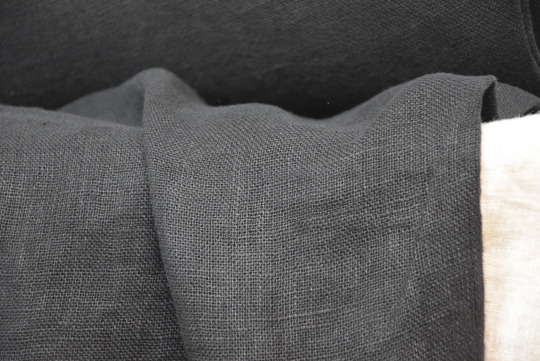
(Image source 1) [ID 1: a gray linen fabric with a tight weave.] / (Image source 2) [ID 2: a gray linen fabric with a loose weave.]
Polyester (to avoid):
Are your summer clothes making you ridiculously sweaty? Check the tag: you're probably wearing polyester.
Polyester is a synthetic fabric derived from petroleum: it's basically a plastic. It's strong, cheap, and stain resistant, which makes it a popular fabric. Even though a lot of summer clothes are made out of polyester, it's one of the worst fabrics to wear in summer.
Polyester is neither absorbent nor breathable, and captures heat. It traps sweat between your skin and your clothes, and it won't let you cool down. This leaves you feeling sticky and overheated. It can also cause static cling, which can be uncomfortable.
Not all synthetic fabrics are bad in summer: a lot of UV-blocking clothes are made of synthetics for example and can be a real life saver if you're sensitive to the sun. Try to avoid polyester if you can, though.
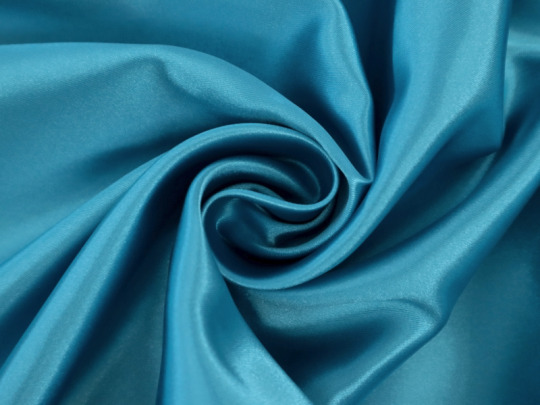
(Image source) [ID: close-up on a blue tightly woven polyester fabric that folds into a swirl at its centre.]
Cotton:
Cotton is a natural fibre that makes for a soft, durable, and breathable fabric. It allows air to circulate around your body which helps to keep you cool and get rid of sweat. It's a good basic choice.
Cotton has one downside: it's very absorbent, but takes a while to dry. If the weather's making you sweat excessively, the sweat can pool into the fabric of your cotton clothes. This will make them wet, resulting in visible sweat stains that can feel uncomfortable and will take a long time to dry.
If you can't stand how cotton feels, check out chambray weaves or bamboo textiles. They have similar properties to plain-weave cotton, but tend to be more sensory-friendly.
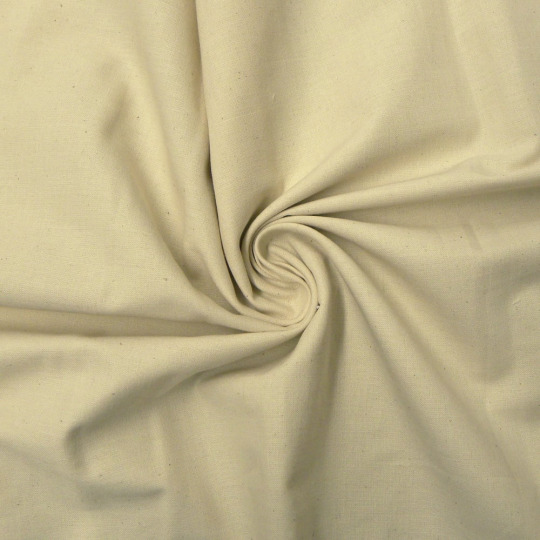
(Image source) [ID: close-up on a faded yellow tightly woven cotton fabric that folds into a swirl at its centre.]
Linen:
Linen is the absolute king of hot weather fabrics. It's strong, absorbent, dries quickly, and is very breathable. It cools you down, but won't make you feel sticky because any sweat it absorbs will evaporate fast.
I frequently layer multiple thin loose-fitting linen garments when it's hot. Loose layers allow for air to circulate between your clothes while protecting your skin from the sun. It almost functions as a wearable air-conditioner.
Note that linen is prone to wrinkling. If this bothers you, know that linen requires extra effort during laundry to avoid this.
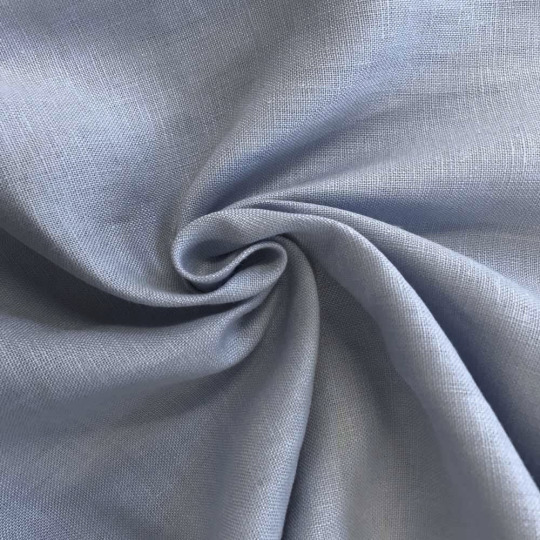
(Image source) [ID: close-up on a gray woven linen fabric that folds into a swirl at its centre.]
Silk:
Silk is yet another natural fibre that makes for a strong, quick-drying, and pretty breathable fabric. It's soft and cool to the touch, which makes it a great sensory choice.
Silk is not as breathable as cotton or linen, but dries very quickly. This means it might make you sweat more than cotton or linen does, but once the fabric's moist it will dry faster.
Note that sweat stains on silk tend to be pretty visible. Silk's also prone to static cling.
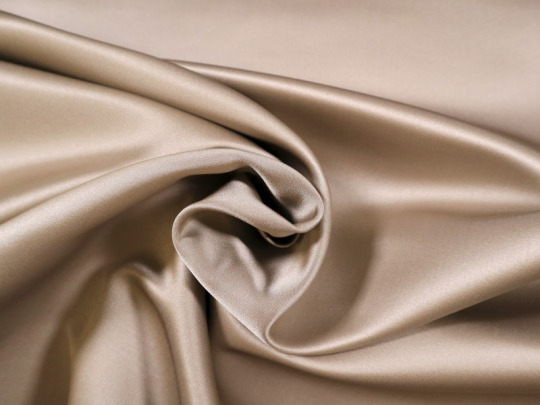
(Image source) [ID: close-up on a light brown tightly woven silk fabric that folds into a swirl at its centre.]
#wasteless crafts#fabric#summer#hot weather#sweat#fibres#silk#linen#polyester#cotton#chambray#bamboo#fabric types#fabric properties#clothes#fashion#keeping cool#heat waves#sunscreen#weather#thrifting#second hand shopping#fast fashion#slow fashion#sustainable fashion#uv blocking fabrics#tw cancer mention#tw skin cancer
2K notes
·
View notes
Text


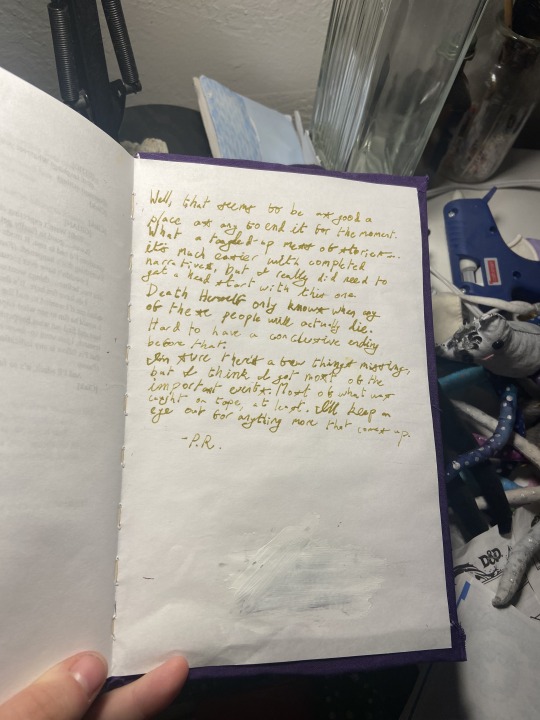

Hey remember when i bound the first half of from the archives? well i've finally done the rest! and honestly i am so proud of it. i tried some new things with the binding, and i am almost completely happy with how it turned out! the only improvement for next time would probably be actually measuring things.
thank you @sixteenth-days for writing something so good i needed to physically bite it.
#ignore the mess in the pictures my desk is the one place in my room that has good lighting and the lamp doesn't like to stay up#it took some finagling#the hermit archives#bookbinding#fanbinding#from the archives#i also spent a lot of time figuring out that handwriting for pix only for it to end up just like mine but loopier#fun though!#it's really strange to look at the first and second parts side by side because the difference in quality is marked#mostly the fabric i was using for the cover was not good! and i should have just gotten some good cotton!#please admire how neat this lettering on the cover is. i am so proud of it#also i need to go back to the first one what with the pix thing in the end and maybe add a note of him donating it to joe. cause that's fun#and i already put the stamp in it#the watchers publishing doesn't mean anything just ''hehe spooky'' basically#plus i put orion publishing on eskew and i figured it would be cool to have something like that on all my books#forgive all this rambling it's like 10 pm
143 notes
·
View notes
Note
questions about your green cotton braided rug project: can you elaborate on what you mean by double folding the cotton strips?
i adore the look of your rug. do you think an amateur (i.e. myself) could create something similar with a sewing machine? i can certainly poke around the internet for patterns/instructions, but im not sure how to judge the difficulty level of your project
Thank you!
If you've seen double folded bias tape, the strips are folded just like that. I'm pressing it in half, and then tucking the two edges in, so I've got a tube with the raw edges inside that's 1/4 the width of the strips I tore. I'm also tearing the yardage first and then sewing the strips together by machine, before I fold them.
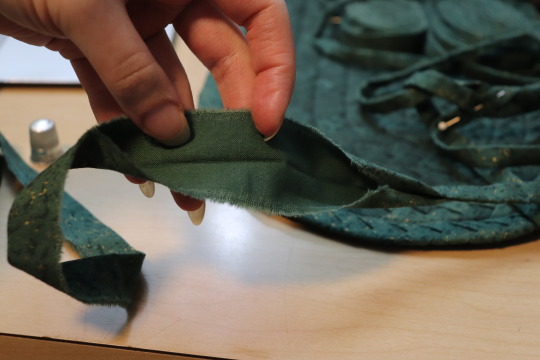
Yeah, I think you could use a machine, at least for the tubes! A little topstitch along the edges would hold them together, or perhaps a tiny zigzag riiiight along the edge would be more inconspicuous. A zig zag that catches the two folded edges on one side and then doesn't on the other size.
Definitely do samples first. Always do samples! I can't test that idea because my machine doesn't do zig zag.
You'll probably still need to whipstitch the braids together from the underside, but that part is much faster than sewing the tubes. And be sure to iron it after adding every round, so the ends don't get dished!
#there are little metal thingies specially made for folding strips like this and I have some but they're meant for much thicker fabric#and didn't work with this cotton so I'm just folding it by hand and it's fine#ask#sewing#rugs#braided rug
99 notes
·
View notes
Text
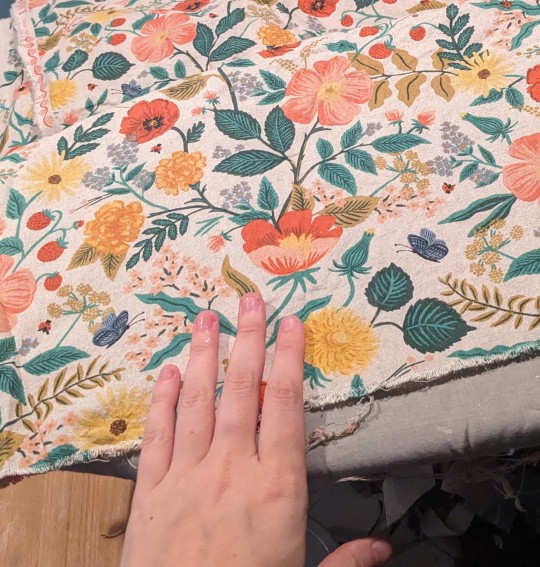

I got fabric for an apron but not thread or strap material so tonight I just cut out the apron and spent some time getting the perimeter hem rolled and prepped for eventual thread acquisition. Shout out to my dear love, light of my life, washable glue stick basting
#sew tag#making up a pattern too! having fun#it's nice to proceed through a project in little chunks and not be TOO annoyed I can't grind it out all at once#note to self: use leftover fabric for tote bag (green fabmo cotton for lining)
110 notes
·
View notes
Text
Sustainable Fabric Supplier: Pioneering the Green Revolution in Textiles
In a world where environmental consciousness is no longer a buzzword but a way of life, the textile industry is undergoing a remarkable transformation. Sustainable and eco-friendly fabrics are at the forefront of this revolution, and finding the right sustainable fabric supplier is crucial for businesses committed to making a positive impact on the environment. In this blog, we will delve into the world of sustainable fabrics, the role of a sustainable fabric supplier, and how this industry is driving the green revolution.
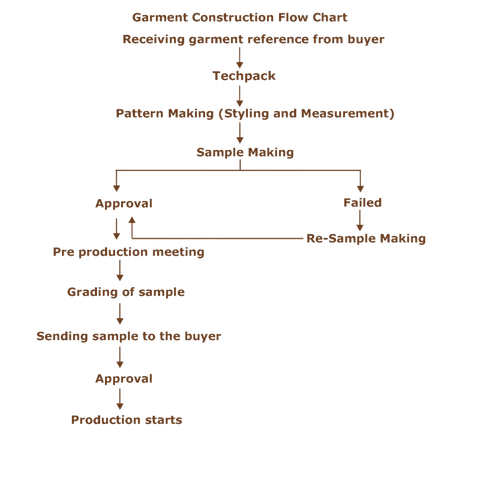


3. *Tencel and Modal*: These fabrics are produced from sustainably sourced wood pulp, often from eucalyptus and beech trees. The closed-loop production process minimizes waste and water usage.
4. *Recycled Fabrics*: These include textiles made from recycled plastic bottles or post-consumer textiles, reducing the need for virgin resources.
5. *Khadi*: Khadi is handspun and handwoven fabric, and its production supports traditional craftsmanship and rural livelihoods.
6. *Peace Silks*: Also known as Ahimsa silk, these are produced without killing silkworms, making them a cruelty-free alternative.

The Role of a Sustainable Fabric Supplier
A sustainable fabric supplier plays a critical role in bridging the gap between environmentally conscious businesses and the growing demand for sustainable textiles. Here are some key responsibilities of a sustainable fabric supplier:
Curating a Diverse Range of Sustainable Fabrics
One of the primary responsibilities of a sustainable fabric supplier is to offer a wide variety of eco-friendly textiles. This ensures that businesses can find fabrics that align with their specific needs, whether it's for clothing, home textiles, or other applications. A diverse inventory of sustainable fabrics enables designers and manufacturers to make eco-conscious choices without compromising on quality or aesthetics.
Ensuring Transparency and Traceability
Transparency is essential in the world of sustainable fabrics. A reputable supplier will provide detailed information about the sourcing and production of each fabric. This includes details about the cultivation, processing, and certification of the textiles. Transparency ensures that the fabrics meet the required environmental and ethical standards.
Meeting Certification Standards
Sustainable fabrics often come with certifications that validate their eco-friendliness. These certifications, such as Global Organic Textile Standard (GOTS), OEKO-TEX, and Fair Trade, provide assurance that the fabrics are produced with minimal harm to the environment and fair labor practices. A reliable sustainable fabric supplier will stock fabrics with relevant certifications, making it easier for businesses to choose the right materials.
Providing Custom Solutions
Different businesses have different needs. A sustainable fabric supplier should offer customization options that allow businesses to tailor fabrics to their specific requirements. Whether it's custom colors, blends, or finishes, these options enable brands to create unique and sustainable products that resonate with their target audience.

Supporting Sustainable Practices
Collaboration with a sustainable fabric supplier is more than just a transaction. It's a partnership in supporting sustainable practices. Suppliers often work with manufacturers to ensure responsible production and offer guidance on reducing waste and optimizing processes.
Sustainable Fabrics: A Game Changer for Fashion and Beyond
Sustainable fabrics are not limited to a niche market; they are gaining momentum in the mainstream fashion industry. Brands are increasingly adopting sustainable textiles as consumer awareness about the environmental impact of fast fashion grows. Sustainable fashion is no longer a trend; it's a paradigm shift.


Choosing the Right Sustainable Fabric Supplier
Selecting the right sustainable fabric supplier is a decision that can impact the trajectory of your business. Here are some factors to consider when evaluating potential suppliers:
1. Product Range:* Look for a supplier with a wide range of sustainable fabrics, so you have a variety of options to choose from.
2. Certifications:* Ensure the supplier's fabrics are certified by recognized organizations, as this provides assurance of their sustainability.
3. Transparency:* The supplier should be transparent about the sourcing and production of their fabrics. They should provide.Share
Back to blog
Leave a comment
Name *Email *Comment *
Please note, comments need to be approved before they are published.
#organic cotton fabric for baby clothes#organic fabric dye#organic cotton fabric suppliers in india#fabric and cotton#fabric from cotton#clothing brands from india#cotton cloth fabrics#cotton material fabric#fabric cotton fabric#cotton fabric#fabric for lehenga#cotton cloth#fabrics stores#fabrics for kurtis#cotton cloth fabric#knitwear material#online fabrics store#knitted fabric material#fabric online stores#cotton materials online#knitted fabric#giza cotton#best indian clothes brand#printmaking fabric#linen fabric linen fabric#linen fabric material#linen cloth material#brands of clothes#brands for clothes#brands in clothes
0 notes
Text






Opened the $.49 fabric bag I got the same trip as Blythe, it's been in the freezer. I couldn't be happier.
After I took that first spread photo (top), I unfolded a piece to see how big it is cut and found ANOTHER coordinating print inside it!!! Then discovered ALL the bunny prints had one or two different additional prints folded up inside them!!
Most are fat eighths, which is enough for doll stuff for sure.
I'm so happy with these, they make my eyeballs happy.
The edge date is 2023 so someone JUST bought these? Wonder how they ended up at the thrift store; these must have cost quite a lot brand new.
38 notes
·
View notes
Text
sometimes you just gotta spend 2 hours late at night making your dad an apron because the muses take you
#i should probably add pockets but i think any more sewing rn would be a Mistake and ive already tempted the ironing gods far too many times#this night#i might post pics tomorrow when i can figure out a way to do it without me or my messy room in it lmao#he had one but it was really shitty and literally made out of plastic so i used some garage sale fabric my granmda gave me one#i sewed them outside in so it's double sided & i used a cutesy fabric on one side which he'll think is funny and a nice navy and white#striped one on the other side & some cotton webbingi had left over for something else for the straps 🤷♀️#i messed up on placing one of the straps & the neck strap is way too big for me personally but that's 1) easy to take in 2) not for my neck#anyway
32 notes
·
View notes
Text
v1 being a hoe



eyestrain for the one below,

#hhrbrhrbr#sketch dump. nervous#uhhhh#ultrakill#suggestive#dont. dont ask me about my fabric physics please. please i dont know where that cotton goes#enjoy. or dont. :thumbsup:#dreamy does art#art from a little bit back tbh that i think other people would wanna see.#q
75 notes
·
View notes
Text
i found an adorable white eyelet fabric & eyelet lace throw blanket at goodwill & pancake has already claimed it as her new favorite blankie, she pawed at me til i put my legs under it so she could lay in my lap between them hehe...she is now fast asleep /ᐠ - ˕-マ。˚ᶻ 𝗓
#it's so cute it has like eyelet ladder lace w pink ribbon sewn in a cross off-center on the fabric#& it's stuffed w a thin layer of cotton inside so it's rly comfy but still lightweight !!#ill post pics later once im done washing my other bedding :3
21 notes
·
View notes